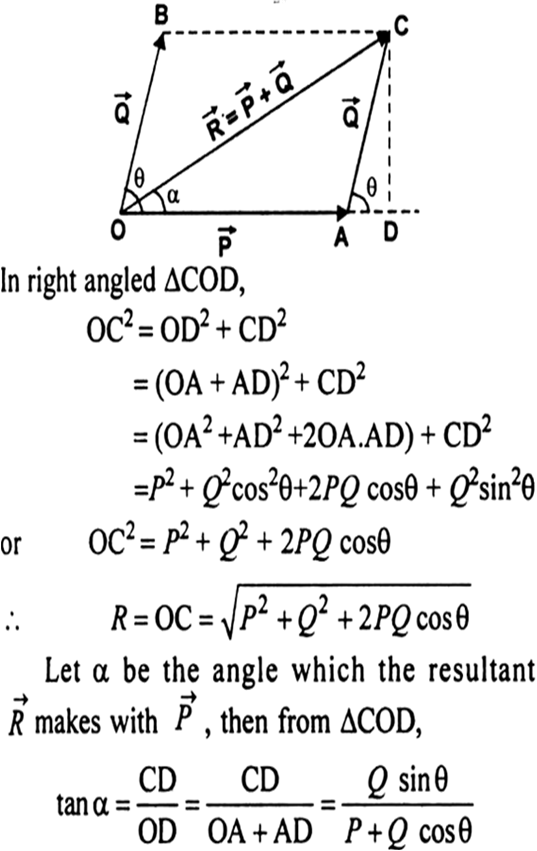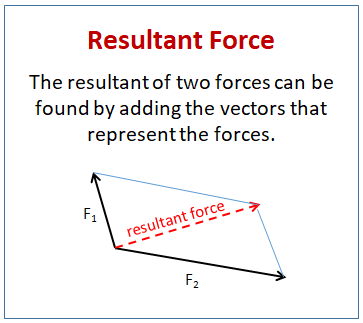Define The Resultant Of Two Or More Vectors
It is the result of adding two or more vectors together. The equilibrant of two or more vectors is defined as that vector which when added to the other vectors products a zero vector as is illustrated in Fg3.
What Is The Resultant Force And How To Find It With Examples Phyley
R Resultant of the Two Vectors P Magnitude of the First Vector Q Magnitude of the Second Vector Inclination Angle between the Two Vectors.

Define the resultant of two or more vectors. The relations between the angles on a right triangle and the sides of the triangle are. How to Find the Resultant of Three or More Vectors - YouTube. How to Find the Resultant of Three or More Vectors.
The resultant of two or more vectors is defined as the vector sum of the vectors as is illustrated in Fig. You might be interested in. The resultant vector is the vector that results from adding two or more vectors together.
The resultant of a vector is the total value after adding two or more vectors together. Match each vocabulary word with appropriate definition. Resulting from the combination of two or more agents.
The two vectors to be added should have the same nature. Resultant vector would be. Verify using an example that Vector a Vector b Vector c Vector a Vector b Vector c is not true.
Find the vector sum of 245 N at 175degree and 294 N at 260degree. The resultant is the vector sum of two or more vectors. A resultant vector is the combination of two or more single vectors.
A resultant vector is the of two or more vectors. The formula for calculating the resultant of two vectors is. Lets solve an example find the resultant of two.
Also find the equilibrant of the sum of the two vectors. The resultant is widely used in number theory either directly or through the discriminant which is essentially the resultant of a. I am very confused.
1 question A resultant vector is the of two or more vectors. There are a two different ways to calculate the resultant vector. For two vectors the vector sum can be obtained by placing them head to tail and drawing the vector.
When used alone the term vector refers to a graphical representation of the. The sum of two or more vectors is known as resultant. R P 2 Q 2 2PQcos Where.
What is the magnitude of resultant vector. Methods for calculating a Resultant Vector. A resultant vector is defined as a single vector whose effect is the same as the combined effect of two or more vectors.
The resultant vector is the vector that results from adding two or more vectors together. There are three displacement vectors. C15546m 2928 North of East.
So a resultant is not just simple summation of the magnitude. Add your answer and earn points. What Is a Resultant Vector.
In some older texts the resultant is also called the eliminant. Force can be added to force and velocity can be added to. Vector addition can be defined as the operation of adding two or more vectors together into a vector sum.
The parallelogram method to calculate resultant vector. Define the term resultant vector Get the answers you need now. The parallelogram law gives the rule for vector addition of two or more vectors.
The equilibrant of two or more vectors is defined as that vector which when added to the other vectors products a zero vector as is illustrated in Fg3. Hopelesunyane91 hopelesunyane91 4 weeks ago Physics High School answered Define the term resultant vector 1 See answer hopelesunyane91 is waiting for your help. Refer to the diagram.
Explain your reasoning both numerically and by using the definition of the dot product. Vector addition method is used to find the resultant. The very first thing we need to do is find the components of each vector.
If displacement vectors A B and C are added together the result will be vector R. 1 on a question A resultant vector is the of two or more vectors. These components are relative to the position of the angle.
The resultant of two or more vectors is defined as the vector sum of the vectors as is illustrated in Fig. A vector has both magnitude and direction. Resultant of 2 vectors P Q is inclined at 45 to either of them.
In mathematics the resultant of two polynomials is a polynomial expression of their coefficients which is equal to zero if and only if the polynomials have a common root or equivalently a common factor. You can calculate a resultant using graphical methods. The head to tail method to calculate a resultant which involves lining up the head of the one vector with the tail of the other.
Following as a result or consequence.

Find The Magnitude And Direction Of Resultant Of Two Vectors Analytically Discuss The Special Cases For Angle Between The Vectors I 0 Ii 180 Iii 90 From Physics Motion In A Plane Class 11 Cbse

Lesson 6 Finding The Resultant Of Two Forces Part 2 Engineering Mechanics Statics Youtube

Find The Magnitude And Direction Of The Resultant Of Two Vectors A And B In The Terms Of Their M Youtube

The Resultant Of Two Forces Solutions Examples Videos Worksheets Games Activities

How To Find The Resultant Of Two Vectors Youtube
What Is The Resultant Of Two Vectors 30n And 40n Acting Parallel To Each Other Quora

Resultant Vector Explanation And Examples

Lesson 1 Vector Addition Numerical
What Is The Vector A Vector B Resultant Vector Magnitude And Direction For X And Y Components Quora

Vectors And Scalars Ppt Download

When Is The Value Of The Resultant Of 2 Vectors Equal To Either Of Them Quora
What Is The Resultant Force And How To Find It With Examples Phyley

Two Forces 3n And 4n Are Acting Perpendicular To Each Other What Is The Magnitude Of The Resultant Force And How Quora

The Resultant Of Two Forces Solutions Examples Videos Worksheets Games Activities

Resultant Vector Explanation And Examples

Vector Application Find Magnitude And Angle Of The Resultant Force Youtube


Posting Komentar untuk "Define The Resultant Of Two Or More Vectors"